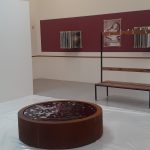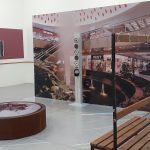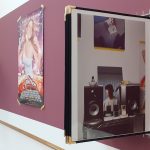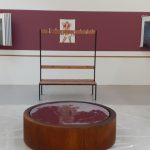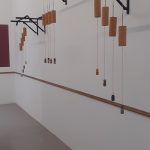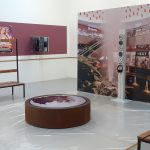London calling | chapter 1
Adam Farah
What I’ve learned from you an myself:
(peak momentations / inside my velvet rope mix)
ITA (English below)
Con l’installazione al Camden Art Centre, l’artista londinese Adam Farah, conosciuto anche come free. yard, richiama memorie e luoghi del proprio passato per riflettere e capire come certi avvenimenti, spazi e persone possano concorrere alla crescita e allo sviluppo della personalità di ogni individuo.
Nel 2020, il Metroland Studio di Kilburn ha organizzato delle residenze d’artista con lo scopo di promuovere giovani artisti di Brent, quartiere situato a nord-ovest di Londra. Tra gli artisti presentati negli spazi della storica venue del Camden Art Centre, nord di Londra, Adam Farah ha creato un ambiente che ritrae proprio alcuni luoghi del quartiere di Brent, spazi che, insieme a determinati momenti, hanno lasciato un segno indelebile sulla sua vita. La nostalgia è sicuramente un sentimento che investe tutta l’opera, anche se l’artista focalizza la sua attenzione sull’elaborazione o rielaborazione del trauma dovuto dalla perdita della madre. Farah rivisita i luoghi della propria infanzia e quelli frequentati con la madre per riflettere su come la morte di quest’ultima abbia contribuito a formare e a cambiare la sua esistenza e personalità (l’artista stesso scrive di come il lutto muti la ‘pelle’ della vita: “mourning is just shedding the skin of life”).
Non solo i luoghi e gli oggetti fotografati ma anche la musica e i poster di Mariah Carey, la fragranza Santal 33 della Le Labo diffusa a intervalli regolari all’interno dello spazio, la cornice decorativa installata attorno all’intera galleria, quale ricordo simbolico degli sforzi compiuti dal padre per abbellire il council flat (casa popolare) in cui viveva con la sua famiglia.
Farah assembla le componenti del suo lavoro non separatamente ma come se questi fossero intrecciati indissolubilmente tra loro, eliminando ogni linearità spaziale e temporale. Per capire meglio questo discorso, basta esaminare la disposizione centrale dell’installazione, dove troviamo: una fontana riempita con bibita gassata KA (un succo d’uva molto popolare tra i teenager londinesi) posta su una moquette beige ricoperta da PVC la quale, a sua volta, è delimitata da due pareti su cui sono poste l’una di fronte all’altra, un’immagine del centro commerciale di Brent Cross che ricopre interamente la superficie, mentre sull’altra è montato uno screen che proietta un video girato in bici attraverso le strade di Brent.
Se la moquette richiama decisamente un ambiente interno, il resto degli oggetti/immagini riproducono ambienti esterni che assumono sia una dimensione pubblica che strettamente privata. Il centro commerciale di Brent Cross, infatti, era uno dei luoghi frequentati dal piccolo Farah e sua madre; la fontana che sembra riprodurre la fontana della fotografia simboleggia uno svincolo stradale di Brent caro all’artista; il video della passeggiata in bici, girato con una fotocamera gopro a 360°, ripropone un tentativo di ‘riscoperta’ del quartiere di Brent seguendo la tecnica del walking, del semplice camminare (a tal riguardo, l’artista dichiara di essere stato influenzato dal film-maker britannico Patrick Keiller). I luoghi esterni, pubblici, accessibili a tutti, diventano nelle esperienze personali di ogni individuo, privati: l’artista associa a ciascuno di questi luoghi dei momenti, delle sensazioni che trasformano gli stessi in spazi privati cui vengono associate determinate esperienze.
Farah si rapporta alle diverse parti dell’installazione quasi seguendo una metodologia proustiana: usa ogni oggetto, immagine, suono, odore come ‘trigger’, come inneschi non propriamente per ricordare o ricostruire il proprio trauma – la perdita di qualcuno a lui caro – ma per riflettere su di esso e capire fino a che punto tale trauma abbia modificato e/o abbia contribuito alla sua personale crescita.
La forza dell’opera di Farah risiede proprio sulla sua simultanea specificità e astrattezza, dovuta dalla disposizione dell’installazione, dalla fusione degli spazi: se da una parte parla di sé e della sua esperienza (e di un particolare ‘endz’ – quartiere – e di una classe sociale – working class) dall’altra, spinge il visitatore a riflettere sulla propria di esperienza e a ripercorrere i propri spazi ‘privati’ e le sensazioni (traumi) associati a essi. Farah stesso, rivolgendosi ai visitatori, scrive nell’introduzione al suo lavoro in riferimento alla (ri)elaborazione di un lutto o di una perdita: “what has that helped you to learn about yourself? If you could dedicate the title of the show to someone in your own life who would it be?” (in cosa ti ha aiutato a capire di te stesso? Se potessi dedicare il titolo dello show a qualcuno nella tua vita, chi sarebbe?).
* * *
ENG
With the installation at Camden Art Centre, the London based artist Adam Farah, also known as free. yard, recalls memories and places from his past to reflect and understand how certain events, spaces and people can contribute to the growth and development of the personality of each individual.
In 2020, Kilburn’s Metroland Studio organised artist residencies with the aim of promoting young artists in Brent, a borough in north-west London. Among the artists displayed in the premises of the historic venue such as Camden Art Centre, north London, Adam Farah has created an environment that portrays some places in the Brent district, spaces that, together with certain moments, have left an indelible mark on his life. Nostalgia is certainly a feeling that surrounds the whole work, even though the artist focuses his attention on the elaboration or re-elaboration of the trauma caused by the loss of his mother. Farah revisits the places of his childhood and those he frequented with his mother to reflect on how the latter’s death helped to shape and change his own existence and personality (the artist himself writes about how mourning changes the ‘skin’ of vita: “mourning is just shedding the skin of life”).
Not only the places and the objects photographed, but also the music and the posters by Mariah Carey; the Santal 33 fragrance by Le Labo diffused at regular intervals within the gallery space; the decorative frame installed around the entire gallery, as a symbolic reminder of the efforts made by his father to decorate the council flat in which Adam lived with his family.
Farah assembles the components of his work not separately but as if they were indissolubly intertwined with each other, eliminating any spatial and temporal linearity. To better understand this point, it is necessary to examine the central arrangement of the installation, where it can be found: a fountain filled with KA carbonated soft drink (a grape juice very popular among London teenagers) placed on a beige carpet covered with PVC which, in its turn, is delimited by two walls on which are fixed one in front of the other, an image of the Brent Cross shopping centre that covers the entire wall surface, while on the other a screen that projects a video shot in bike through the streets of Brent.
If the carpet definitely recalls an internal environment, the rest of the objects / images reproduce external spaces that take on both a public and a strictly private dimension. Brent Cross shopping centre was one of those places visited by little Farah and his mother; the fountain, that seems to reproduce the fountain of the photograph, symbolises a Brent junction dear to the artist; the video of the bike ride, shot with a 360 ° go-pro camera, proposes an attempt to ‘rediscover’ the Brent district following the technique of walking (in this regard, the artist declares to have been influenced by British filmmaker Patrick Keiller). External, public places accessible to all, become private in the personal experiences of each individual: the artist associates moments with each of these places, sensations that transform them into private spaces to which certain experiences are associated.
Farah relates to the different parts of the installation almost following a Proustian methodology: he uses every object, image, sound, smell as triggers, not really to remember or reconstruct his own trauma – the loss of someone dear to him – but to reflect on it and understand to what extent such a trauma has modified and / or contributed to his personal growth.
The strength of Farah’s work lies precisely in its simultaneous specificity and abstractness, due to the arrangement of the installation, the fusion of spaces: if on the one hand it speaks of itself and its experience (and of a particular ‘endz’ – neighbourhood – and of a social class – working class) on the other, pushes the visitor to reflect on his own experience and to retrace his own ‘private’ spaces and the sensations (traumas) associated with them. Farah himself, addressing the visitors, writes in the introduction to his work in reference to the (re) elaboration of a bereavement or a loss: “what has that helped you to learn about yourself? If you could dedicate the title of the show to someone in your own life, who would it be? “.

